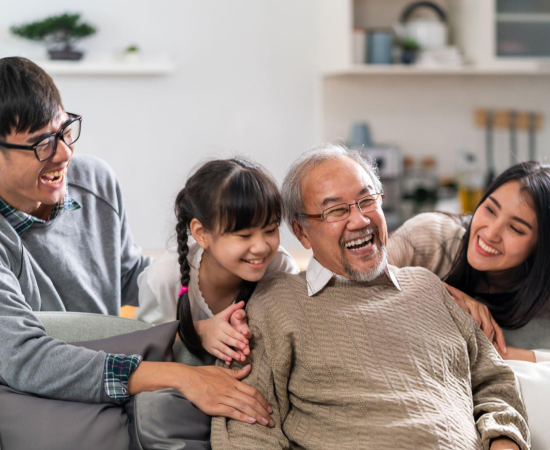

Ageing is a natural process that changes our needs and abilities, leading many seniors to prefer staying in their own homes instead of moving to assisted living facilities. This concept, known as ageing in place, allows older adults to maintain their independence and quality of life in the place they have spent most of their lives in. To make this possible, homes need to be modified for safety, accessibility, and convenience.
The theory of ageing in place is based on the idea that older adults should have the opportunity to live in their homes safely, independently, and comfortably, regardless of age or ability. This theory recognises that familiarity, emotional attachment, and a sense of belonging are essential for well-being.
Ageing in place is supported by several theoretical frameworks:
This theory states that a person’s well-being is influenced by their ability to adapt to their surroundings; making adjustments to the home can help accommodate changing mobility and health needs.
Ageing in place helps older adults maintain familiar routines and social connections, allowing them to thrive with minimal disruptions to their lifestyle.
This theory emphasises the relationship between individuals and their environment. A home that evolves with a person’s needs can enhance safety and quality of life.
Ageing in place offers numerous advantages over moving to assisted living facilities. Here are some key benefits:
Seniors often have deep emotional connections with their homes, filled with memories and familiarity. Staying in a known environment reduces stress, anxiety, and depression, promoting mental health and overall well-being.
Living at home allows seniors to make their own decisions, manage their schedules, and maintain their lifestyle without restrictions imposed by a facility. This independence boosts self-esteem and confidence.
The cost of assisted living or nursing homes can be overwhelming. Ageing in place, with necessary home modifications and caregiving support, is often a more affordable option.
Remaining in their community helps seniors stay connected with friends, neighbours, and family members, reducing feelings of loneliness and isolation.
Ageing in place allows seniors to receive customised healthcare and assistance based on their needs. They can opt for professional caregivers, family support, or home health services.
With the right home modifications, a senior’s home can be transformed into a safe, accessible, and comfortable space, reducing the risk of falls and injuries.
To successfully age in place, homes need to be adapted to accommodate mobility challenges and other age-related concerns. Here’s how to modify each part of the home:
Make buildings more accessible by installing ramps, wide doorways, lever-style door handles, and motion-sensor lighting at entry points.
Create a safe and accessible living space by removing excess furniture, securing rugs, and incorporating smart home automation. Opt for comfortable chairs with armrests for easier sitting and standing.
To make the kitchen more accessible and safer, you can install pull-out shelves and lazy Susans for easy access, lower countertops for wheelchair users, use anti-slip flooring and adequate lighting, and replace gas stoves with induction cooktops to prevent fire hazards.
Choose a bed at the right height, install grab bars for stability, use touch-sensor bedside lamps, and keep an emergency call button or medical alert system nearby for safety and ease of use.
The recommended modifications for a senior-friendly bathroom include installing grab bars, using a walk-in bathtub or curbless shower with a seat, ensuring non-slip mats and textured flooring, opting for a raised toilet seat, and installing handheld showerheads for better control.
To improve accessibility and safety in multi-storey homes, consider installing stairlifts or elevators, adding handrails on both sides of the staircase, ensuring well-lit hallways with motion sensors, and using contrasting colours on steps for better visibility.
Technology provides seniors with enhanced safety and convenience through medical alert systems, voice-activated assistants, smart doorbells, security cameras, and automated lighting and thermostat controls.
Seniors can age in place by planning for their needs, making housing adjustments, securing financial support, and establishing a care network with the help of a step-by-step guide.
Consider existing health conditions, mobility limitations, and potential future needs. Consulting an occupational therapist or a home modification specialist can provide personalised recommendations.
Ageing in place at home is cheaper than nursing homes, but it’s important to budget for home modifications and care. Consider government programmes, long-term care insurance, savings, and family contributions to cover costs.
It is important to have support from family, friends, and professional caregivers for well-being. Consider hiring home health aides for personal care, housekeeping services for household tasks, and transportation assistance for getting around.
Conduct routine inspections of the home to ensure all modifications remain functional and safe. Update features as needed.
Be prepared for emergencies by installing alert systems, keeping a contact list handy, and having plans for fire escapes and medical emergencies.

Ageing in place is a popular choice for seniors, providing emotional, financial, and practical advantages. By modifying their homes, seniors can stay comfortable, secure, and independent in a familiar setting. Well-adapted homes promote well-being and lessen the need for institutional care.
With proper planning, home modifications, and support, seniors can continue to live fulfilling lives in their own homes. If you’re thinking about ageing in place, start evaluating home changes now for a safe and happy future.
Sources:
Spread the love, follow us on our social media channels